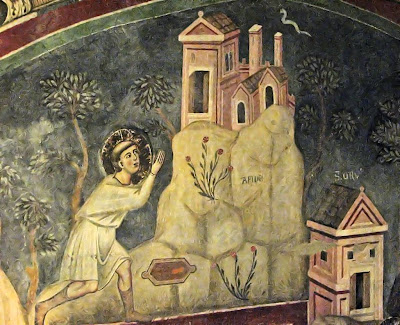Where did Medieval Christendom start? Who was its Founder?
The answer is paradoxal. It started in a grotto. Its Founder was a hermit, a young Roman who fled Rome's immorality and decay -- Rome that was soon to be drowned in blood and fire.
He was the great Saint Benedict, the Patriarch of the West, the great soul that sparked the immense medieval order, just and sacral.
Saint Benedict founded the Benedictine Order, that still exists today. Around the Benedictine monasteries gathered survivors from the shipwrecked Roman Empire and bands of barbarians.
The Benedictine abbots taught them order. And under the influence of grace, they produced the marvelous Medieval Order.
But where did it all start? Where was the grotto where Saint Benedict alone started his spiritual epic?
The place still exists. It's called Subiaco. And it's not too far from Rome.
In the grotto of Bethlehem, our Savior came to the world. In the grotto of Subiaco, Christendom took its first step in the soul of the great Benedict of Núrsia.
Saint Benedict's great soul was like an immense fire of zeal for God's cause. Charlemagne and the other heroes and saints that followed were like sparks from this huge fire.
Let us look at these paintings and imagine the great saint praying alone, listening to the wild beasts, eating his daily bread brought by a crow.
* * *
The paintings give us a visual of the surroundings of the famous grotto where Saint Benedict lived alone for years. This blessed spot was the starting point of Christian Civilization, as it came about in Western Europe.
In the fifth century, Europe was in a difficult situation: barbarians had occupied the Roman Empire of the West. The remnants of civilization coexisted with large numbers of barbarians. Chaos was the result of that mixing, and the chaos had to be fixed.
With the help of grace, the Church worked hard at this. And grace came in abundance and was well received in many souls and produced fruits that prepared the way for something great and beautiful to happen.
Then a young man from a senatorial Roman family, a noble Patrician family, appeared on the scene. Benedict, raised up by God for a great mission, dedicated himself entirely to this grandiose vocation.
But to accomplish his mission he had to flee the mixture of barbarianism and decadent Roman culture that reigned in Europe.
He became a hermit. Why? To become a saint. He went out to a distant cave where nothing would disturb his complete consecration to Our Lord.
There he practiced devotions and meditation and penance so grace would take ever more complete possession of his soul.
Let us imagine the young Benedict. He did not think of his talents. He didn't admire what he was doing. He didn't think of himself, but only of God's glory.
* * *
Let us imagine Saint Benedict alone in that beautiful, isolated grotto. His daily interaction was with rugged rocks and stones, without any special physical beauty.
All is solitude. But all evokes Heaven in some way or another. Picture him alone in that distant cave, reading and thinking.
He didn't know it, but through the graces he was receiving, European Civilization was starting.
But even better - much better than Europe itself - European Christendom was being born!
From:






No comments:
Post a Comment